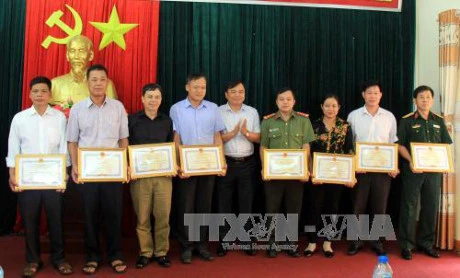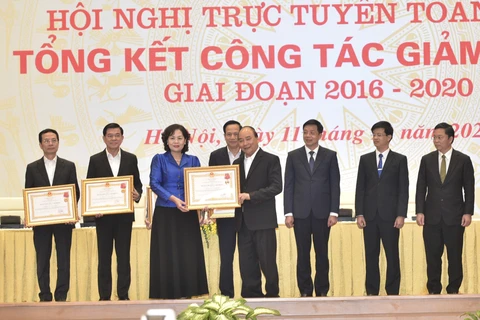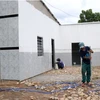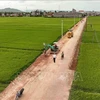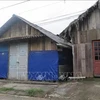 Growing Sa nhan tim (Amomum Longiligulare T.L.Wu ), a valuable medical plant, helps local residents in Dien Bien province escape poverty and improve their lives. (Photo: VNA)
Growing Sa nhan tim (Amomum Longiligulare T.L.Wu ), a valuable medical plant, helps local residents in Dien Bien province escape poverty and improve their lives. (Photo: VNA) Under the leadership of the Party and the Government, localities nationwide have implemented solutions and programmes to help local people develop suitable livelihood models to escape poverty and improve their lives, especially in 2016-2020.
The Muong Nhe Nature Reserve in the northern province of Dien Bien started to implement a project to develop the livelihood based on the forest in five communes in the buffer zone of the forest.
The project of planting Sa nhan tim (Amomum longiligulare T.L.Wu), a valuable species of medical plants, was first conducted in Sin Thau commune, the westernmost area of the country.
Initially, local people were reluctant to join the project as they were unaware of the economic benefits gained from growing the plant.
Po Dan Sinh, a Ha Nhi ethnic resident in Ta Ko Khu village of the commune, was a pioneer in implementing this project. Sinh, a former Party Secretary and Chairman of the People’s Committee of Sin Thau in 2000-2015, set an example for locals. Witnessing his success, the local residents followed suit.
Sa nhan tim is a valuable plant that can be used as traditional medicine, spice and a source of aromatic material.
Vietnam is rich in wild Amomum Longiligulare and at least four species are commonly used in the country including Amomum Longiligulare T.L.Wu. The demand for this plant is increasing while the amount of the plant collected is decreasing.
The medical plant is easy to take care of and can be sold at a good price. Planting this in mountainous areas also helps the forest as the plants have a high moisture level, helping to prevent fires as well as soil erosion in the forest.
Local farmers can harvest the first crop after about two years with a hectare yielding about 100kg of fruits. Dried fruits can be sold at 500,000 VND (21.7 USD) per kilo.
The success in Sin Thau had a ripple effect. Local residents in other localities including Nam Po, Muong Cha, Dien Bien, Tuan Giao and Tua Chua started planting this species and earned income.
The programmes and solutions to alleviate poverty have had positive results in the district. After five years of implementing the national target programme on sustainable poverty reduction, the rate of the poor households in the district decreased from 74.02 percent in 2015 to 58.43 percent in 2020.
Muong Nhe district in Dien Bien is only one of the localities across the nation working to help local residents develop suitable livelihoods to improve their life.
The Party and State have identified sustainable poverty reduction and ensuring social security as an important goal in the development process, which is clearly shown in the documents of the Party, the resolutions of the National Assembly, and strategies, plans, schemes and programmes of the Government.
The National Steering Committee on National Target Programme on Sustainable Poverty Reduction during 2016-2020 has been assisting Prime Minister Nguyen Xuan Phuc in directing and coordinating ministries, agencies and localities to resolve issues related to mechanisms and policies to realise poverty reduction objectives.
All 63 provinces and cities of Vietnam have also released several policies regarding poverty reduction to support poor households.
Bac Kan province has issued policies to encourage poor households to develop plants and breeds that are suitable with the local climate, soil and bring high economic benefits.
Hanoi has supported those who are unable to escape poverty while Ho Chi Minh City has constructed a sustainable poverty reduction strategy within its overall socio-economic development plan.
With such persistent efforts, milestone achievements have been attained with more than 6 million people escaping poverty in 2016-2019. Roughly 2 million people were also removed from the list of those living under the poverty line in the same period.
The number of poor households decreased 40.66 percent in Si Ma Cai district and 39.96 percent in Muong Khuong district in Lao Cai province, and 34.51 percent in Mu Cang Chai district in Yen Bai province.
Once calculated, the poverty rate in Vietnam is expected to stand at 2.75 percent in 2020.
By achieving this, the rate of the poor households will have decreased by 1.43 percent a year, meeting the targets set by the National Assembly and the Resolution of the 12th National Party Congress.
What is more, Vietnam attained the UN's Millennium Development Goals on poverty reduction 10 years ahead of schedule and was hailed as a global model in the task.
Despite the impressive results, there are limitations that need to be tackled in poverty reduction.
According to the National Steering Committee on National Target Programme on Sustainable Poverty Reduction in 2016-2020, poverty alleviation is still not sustainable with a high rate of poor households and the increasing gap between the rich and poor as well as among the groups. The poverty rate among ethnic minority groups is still high.
In addition, some mechanisms and policies for poor areas, mountainous areas, and ethnic minority areas are ineffective.
In late 2020, the Government set new poverty standards for 2021-2025. With this new standard, the country will have about 4.5 million households with income below the poverty line, equivalent to more than 17 million people, which is a huge challenge for the country.
However, this will serve as a basis for more accurate and comprehensive identification of poor households, near-poor households and other beneficiaries of national poverty reduction and social security policies.
The national multidimensional poverty line in 2021-2025 will also serve as the basis for making policies, mechanisms and solutions to achieve multidimensional, inclusive and sustainable poverty reduction./.
VNA
